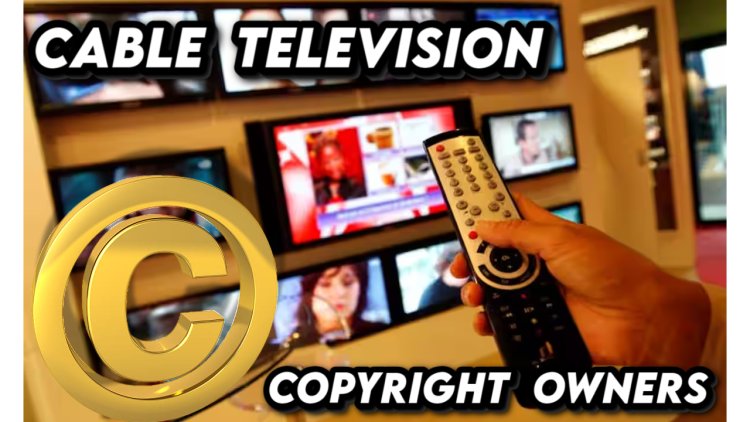Cable Television and Copyright Owners
This article explores the intricate relationship between cable television and copyright owners, delving into the challenges and opportunities that arise in the digital age. As cable television continues to be a primary means of content distribution, the intersection with copyright laws is crucial. This article examines the evolution of this relationship, the legal frameworks governing it, and the emerging issues faced by both cable providers and copyright owners. By analyzing key court cases, technological advancements, and potential solutions, the article aims to shed light on the current state of affairs and the future trajectory of cable television and copyright ownership.

Introduction:
Cable television has been a cornerstone of content distribution for decades, connecting audiences with a diverse array of programming. However, the symbiotic relationship between cable providers and copyright owners has been riddled with legal complexities and challenges. This article explores the evolving dynamics of this relationship, examining the historical context, legal frameworks, and contemporary issues faced by both parties in the digital age.
Evolution of Cable Television and Copyright Ownership:
The inception of cable television marked a revolutionary shift in how audiences consumed content. With the ability to transmit signals over long distances, cable providers offered viewers access to a multitude of channels. This shift, however, raised questions about the rights of copyright owners, who sought to protect their intellectual property in this new distribution landscape.
Legal Frameworks Governing Cable Television and Copyright:
The relationship between cable television and copyright owners is intricately woven into the legal frameworks that govern intellectual property rights. The Cable Communications Policy Act of 1984 in the United States laid the groundwork for regulating the cable industry, addressing issues such as retransmission consent and compulsory licensing. Additionally, the Digital Millennium Copyright Act (DMCA) introduced in 1998 aimed to address copyright challenges posed by the digital era, including provisions for internet service providers and safe harbors.
Retransmission Consent and Compulsory Licensing:
Retransmission consent and compulsory licensing are central components of the legal framework governing the relationship between cable television providers and copyright owners. Retransmission consent requires cable operators to obtain permission from broadcasters before transmitting their content, while compulsory licensing establishes a mechanism for cable operators to obtain the rights to retransmit broadcast content for a fee set by the government.
Court Cases Shaping the Landscape:
Over the years, several court cases have played a pivotal role in shaping the relationship between cable television and copyright owners. Notable cases, such as Sony Corp. v. Universal City Studios (1984) and American Broadcasting Companies, Inc. v. Aereo, Inc. (2014), have addressed issues related to time-shifting, cloud-based services, and the definition of public performance, influencing the legal landscape for content distribution.
Technological Advancements and Emerging Challenges:
The digital age has brought about unprecedented technological advancements, transforming the way content is produced, distributed, and consumed. Cable providers face new challenges as streaming services, video-on-demand platforms, and over-the-top (OTT) solutions gain prominence. The emergence of these technologies raises questions about licensing agreements, territorial rights, and the protection of copyrighted material in an increasingly interconnected global market.
Copyright Protection in the Digital Age:
Protecting copyright in the digital age requires a delicate balance between the interests of content creators, cable providers, and consumers. Digital rights management (DRM) technologies have been employed to safeguard content, but their effectiveness is a subject of debate. Striking the right balance between protecting intellectual property and ensuring access to content is crucial for the sustainable growth of the industry.
Emerging Solutions and Collaborative Approaches:
As the landscape continues to evolve, collaborative approaches and innovative solutions are essential for addressing the challenges faced by cable providers and copyright owners. This includes exploring new licensing models, embracing technology to track and manage rights, and fostering open communication between stakeholders to establish mutually beneficial agreements.
International Perspectives and Harmonization:
In an era of global connectivity, the relationship between cable television and copyright owners extends beyond national borders. International collaboration and harmonization of legal frameworks are critical to creating a cohesive environment that respects the rights of copyright owners while facilitating the cross-border distribution of content.
Conclusion:
In conclusion, the relationship between cable television and copyright owners is a dynamic interplay of technological advancements, legal frameworks, and evolving consumer preferences. The historical context, legal foundations, and emerging challenges underscore the need for continuous adaptation within the industry. As cable providers and copyright owners navigate this complex landscape, collaborative approaches, technological innovation, and international harmonization will be key to ensuring a sustainable and equitable future for content distribution in the digital age.












